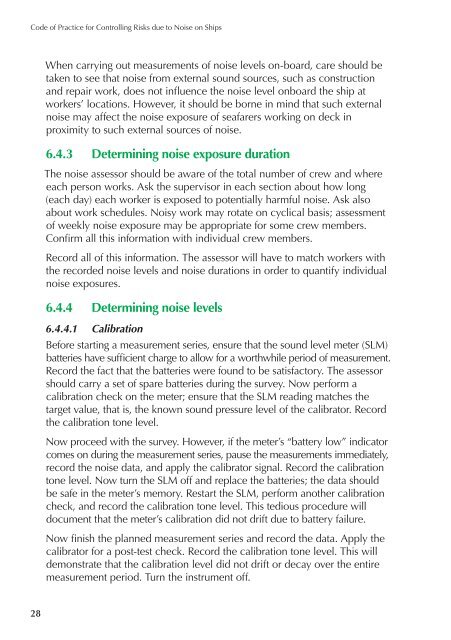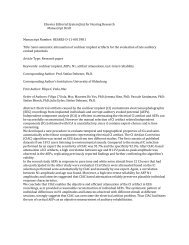5958_MCA Noise v2_4.indd - Institute of Sound and Vibration ...
5958_MCA Noise v2_4.indd - Institute of Sound and Vibration ...
5958_MCA Noise v2_4.indd - Institute of Sound and Vibration ...
Create successful ePaper yourself
Turn your PDF publications into a flip-book with our unique Google optimized e-Paper software.
Code <strong>of</strong> Practice for Controlling Risks due to <strong>Noise</strong> on Ships<br />
28<br />
When carrying out measurements <strong>of</strong> noise levels on‑board, care should be<br />
taken to see that noise from external sound sources, such as construction<br />
<strong>and</strong> repair work, does not influence the noise level onboard the ship at<br />
workers’ locations. However, it should be borne in mind that such external<br />
noise may affect the noise exposure <strong>of</strong> seafarers working on deck in<br />
proximity to such external sources <strong>of</strong> noise.<br />
6.4.3 Determining noise exposure duration<br />
The noise assessor should be aware <strong>of</strong> the total number <strong>of</strong> crew <strong>and</strong> where<br />
each person works. Ask the supervisor in each section about how long<br />
(each day) each worker is exposed to potentially harmful noise. Ask also<br />
about work schedules. Noisy work may rotate on cyclical basis; assessment<br />
<strong>of</strong> weekly noise exposure may be appropriate for some crew members.<br />
Confirm all this information with individual crew members.<br />
Record all <strong>of</strong> this information. The assessor will have to match workers with<br />
the recorded noise levels <strong>and</strong> noise durations in order to quantify individual<br />
noise exposures.<br />
6.4.4 Determining noise levels<br />
6.4.4.1 Calibration<br />
Before starting a measurement series, ensure that the sound level meter (SLM)<br />
batteries have sufficient charge to allow for a worthwhile period <strong>of</strong> measurement.<br />
Record the fact that the batteries were found to be satisfactory. The assessor<br />
should carry a set <strong>of</strong> spare batteries during the survey. Now perform a<br />
calibration check on the meter; ensure that the SLM reading matches the<br />
target value, that is, the known sound pressure level <strong>of</strong> the calibrator. Record<br />
the calibration tone level.<br />
Now proceed with the survey. However, if the meter’s “battery low” indicator<br />
comes on during the measurement series, pause the measurements immediately,<br />
record the noise data, <strong>and</strong> apply the calibrator signal. Record the calibration<br />
tone level. Now turn the SLM <strong>of</strong>f <strong>and</strong> replace the batteries; the data should<br />
be safe in the meter’s memory. Restart the SLM, perform another calibration<br />
check, <strong>and</strong> record the calibration tone level. This tedious procedure will<br />
document that the meter’s calibration did not drift due to battery failure.<br />
Now finish the planned measurement series <strong>and</strong> record the data. Apply the<br />
calibrator for a post‑test check. Record the calibration tone level. This will<br />
demonstrate that the calibration level did not drift or decay over the entire<br />
measurement period. Turn the instrument <strong>of</strong>f.<br />
<strong>5958</strong>_<strong>MCA</strong> <strong>Noise</strong> <strong>v2</strong>_<strong>4.indd</strong> 28 26/2/10 10:02:02
















